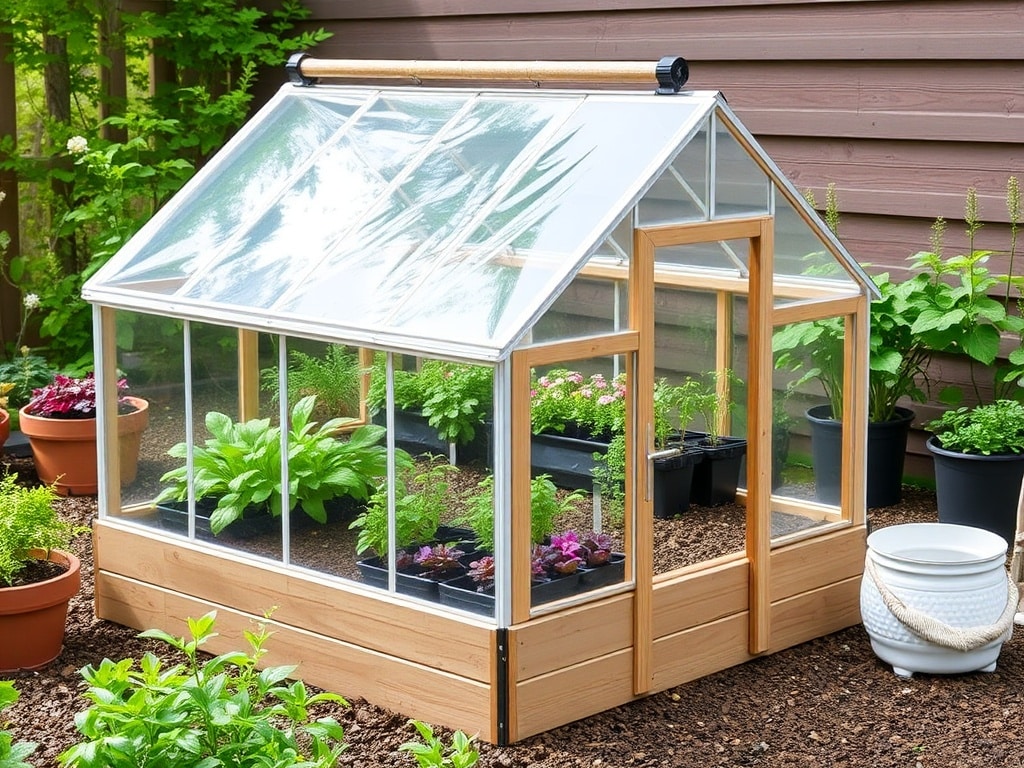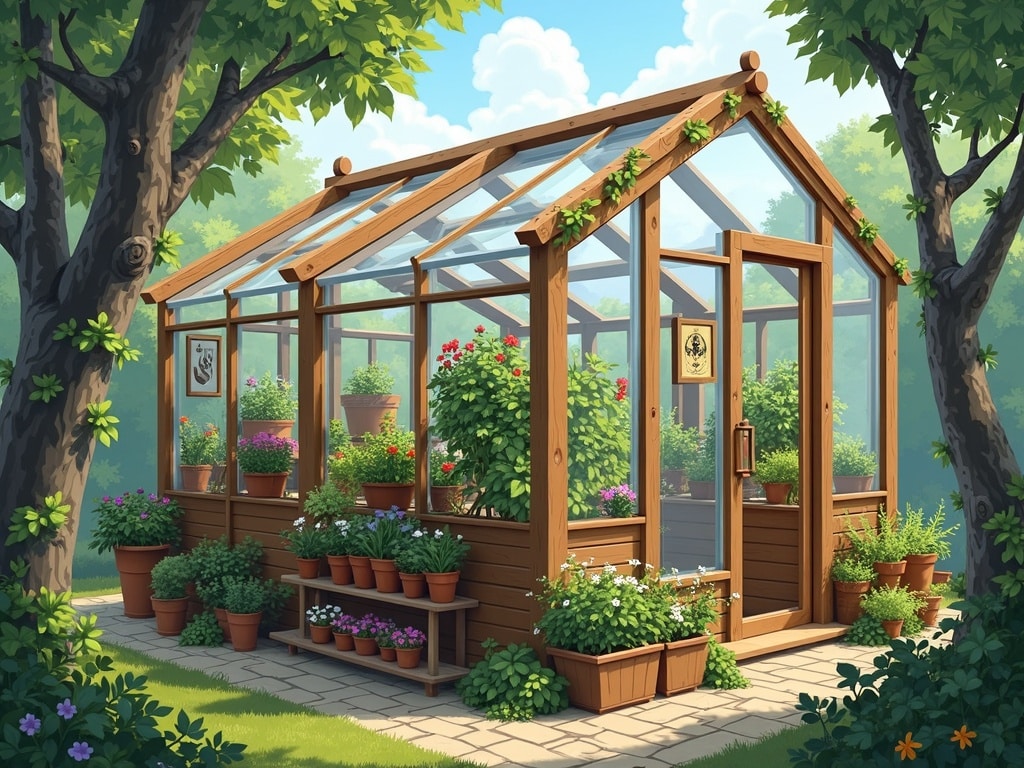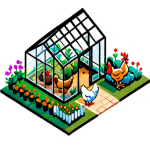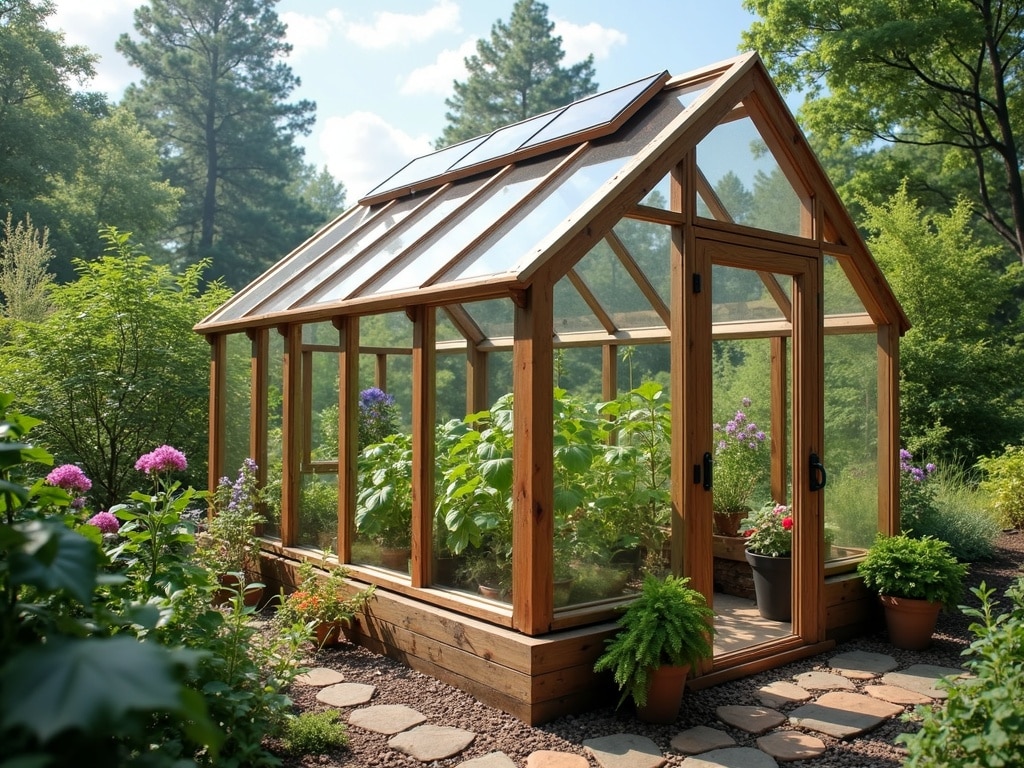Budget-Friendly DIY Small Greenhouse: A Beginner's Guide
Introduction: Cultivating Your Dreams with DIY Small Greenhouse Plans
Imagine stepping into a warm, humid space filled with the vibrant greens of your favorite vegetables, even in the dead of winter. A small greenhouse can transform this dream into reality, extending your growing season and allowing you to cultivate a wider variety of plants. But the idea of constructing a greenhouse can seem daunting, especially on a tight budget. Fear not! This guide is your comprehensive roadmap to building a budget-friendly, DIY small greenhouse. We'll explore various DIY small greenhouse plans, from simple recycled structures to more elaborate pallet greenhouses, empowering you to take control of your food production and nurture your green thumb without breaking the bank.
1. What are the Benefits of Having a Small Greenhouse?
A small greenhouse provides a multitude of benefits for the avid gardener and those aspiring to greater food self-sufficiency. Beyond simply extending the growing season, a greenhouse offers:
- Extended Growing Season: Start seedlings earlier in the spring and continue harvesting well into the fall and winter.
- Protection from the Elements: Shield your plants from harsh weather conditions like frost, heavy rain, strong winds, and excessive heat.
- Pest and Disease Control: A controlled environment minimizes the risk of pest infestations and diseases.
- Optimal Growing Conditions: Regulate temperature, humidity, and light levels to create the ideal environment for your plants.
- Increased Yields: By optimizing growing conditions, you can often achieve higher yields compared to outdoor gardening.
- Year-Round Gardening: In milder climates, a greenhouse can allow you to garden year-round.
- Self-Sufficiency: Grow your own fruits, vegetables, and herbs, reducing your reliance on store-bought produce, and increasing your food independence.
2. What Materials Can I Use to Build a DIY Small Greenhouse on a Budget?
The beauty of DIY greenhouses lies in their adaptability and the potential for using readily available and inexpensive materials. Here are some budget-friendly options:
- Reclaimed Wood: Pallets, old fences, and leftover lumber can be repurposed for framing.
- PVC Pipes: Lightweight, durable, and easy to work with for creating hoop house structures.
- Polyethylene Film (Poly Film): Inexpensive and readily available for greenhouse covering. Choose a thicker gauge for added durability.
- Repurposed Windows and Doors: Excellent for creating a sturdy and aesthetically pleasing greenhouse structure.
- Recycled Plastic Bottles: Use them to create a unique and eco-friendly bottle brick greenhouse.
- Hardware Cloth: Provides ventilation and protection from pests.
- Fasteners: Screws, nails, and zip ties are essential for assembling your greenhouse.
- Concrete Blocks or Bricks: Create a stable foundation for your greenhouse.
3. What are some Simple DIY Small Greenhouse Designs for Beginners?

For beginners eager to embark on their greenhouse journey, simplicity is key. Here are a few easy-to-build designs:
- Cold Frame: A simple, box-like structure with a slanted, transparent lid to trap sunlight. Ideal for protecting seedlings or overwintering plants.
- Hoop House: Constructed using bent PVC pipes covered with poly film. A cost-effective and easy-to-assemble option.
- Lean-To Greenhouse: Built against an existing wall of your house or shed, utilizing the structure for support and heat retention.
- Pallet Greenhouse: Utilizes recycled pallets as the primary building material for both the frame and walls.
- Mini Greenhouse on Wheels: A small, portable greenhouse built on a trolley or cart, ideal for limited spaces.
4. How Do I Choose the Right Location for My DIY Small Greenhouse?
The location of your greenhouse is crucial for its success. Consider these factors when selecting a site:
- Sunlight: Choose a location that receives at least 6 hours of direct sunlight per day, especially during the winter months. A south-facing location is generally ideal.
- Protection from Wind: Select a site that is sheltered from strong winds, which can damage the greenhouse and reduce its heating efficiency. Use existing structures, trees, or fences to provide wind protection.
- Accessibility: Ensure easy access to water and electricity, if needed.
- Drainage: Avoid low-lying areas that are prone to flooding. Good drainage is essential to prevent root rot and other water-related problems.
- Level Ground: Choose a relatively level site to simplify construction and ensure stability.
5. How Do I Build a Mini Greenhouse Using Recycled Materials?
Building a mini greenhouse from recycled materials is a great way to save money and reduce your environmental impact. Here's a simple project using plastic bottles:
- Collect Plastic Bottles: Gather a large number of plastic bottles of similar size and shape.
- Prepare the Bottles: Remove the labels and thoroughly clean the bottles. Cut off the bottoms of the bottles.
- Create the Bottle Bricks: Thread the bottles onto a sturdy stick or rod, creating a long brick of plastic bottles.
- Build the Frame: Build a simple wooden frame for your mini greenhouse.
- Attach the Bottle Bricks: Attach the bottle bricks to the frame using wire or zip ties, creating the walls and roof of the greenhouse.
- Add a Door: Create a small door using scrap wood and hinges.
6. How Do I Build a Pallet Greenhouse on a Budget?
Pallet greenhouses are a popular and cost-effective option, utilizing readily available recycled pallets. Here's a basic approach:
- Source Pallets: Find free or inexpensive pallets. Ensure they are heat-treated (HT) and not chemically treated (look for the IPPC stamp).
- Design Your Greenhouse: Decide on the size and shape of your greenhouse.
- Prepare the Pallets: Clean and sand the pallets to remove splinters.
- Construct the Frame: Assemble the pallets to create the walls of the greenhouse. Secure them together with screws or nails.
- Build the Roof: Construct a roof frame using lumber or additional pallets.
- Cover the Greenhouse: Cover the walls and roof with poly film, greenhouse plastic, or repurposed windows.
- Add a Door and Ventilation: Install a door and create vents for airflow.
7. How Do I Build a Hoop House Greenhouse?
Hoop houses are simple, affordable, and effective. Here's how to build one:
- Gather Materials: PVC pipes, poly film, metal stakes, and fasteners.
- Drive in Stakes: Drive metal stakes into the ground along the perimeter of your desired greenhouse footprint.
- Bend and Insert PVC Pipes: Bend the PVC pipes into arches and insert the ends over the stakes.
- Secure the Arches: Use cross braces made of PVC pipe to connect the arches and provide stability.
- Cover with Poly Film: Drape the poly film over the arches and secure it to the frame with clips or tape.
- Create Doors and Ventilation: Cut openings for doors and add ventilation flaps.
8. How Do I Build an A-Frame Greenhouse?
A-frame greenhouses offer a classic look and good structural stability. Here's a simplified building process:
- Build A-Frame Supports: Construct triangular A-frame supports from lumber.
- Connect the Supports: Connect the A-frame supports with horizontal beams to create the frame of the greenhouse.
- Add Sheathing: Cover the frame with plywood or lumber sheathing.
- Install Glazing: Install clear glazing material, such as polycarbonate panels or greenhouse plastic, to the frame.
- Add Doors and Ventilation: Install a door and create vents for airflow.

9. What are the Essential Tools Needed to Build a DIY Small Greenhouse?
Having the right tools will make your greenhouse construction project much smoother. Here's a list of essential tools:
- Measuring Tape: For accurate measurements.
- Saw: For cutting wood or PVC pipes.
- Drill: For drilling holes and driving screws.
- Screwdriver: For tightening screws.
- Hammer: For driving nails.
- Staple Gun: For securing poly film or other materials.
- Level: For ensuring level surfaces.
- Gloves: To protect your hands.
- Safety Glasses: To protect your eyes.
- Utility Knife: For cutting poly film or other materials.
10. How Do I Heat and Ventilate My DIY Small Greenhouse Effectively?
Maintaining the right temperature and airflow is crucial for plant health. Here are some heating and ventilation strategies:
- Passive Solar Heating: Maximize sunlight exposure to heat the greenhouse naturally.
- Thermal Mass: Use materials like water barrels or concrete blocks to absorb heat during the day and release it at night.
- Electric Heater: Use a small electric heater with a thermostat to maintain a consistent temperature during cold nights (use cautiously and with proper safety measures).
- Ventilation: Install vents at the top and bottom of the greenhouse to allow for airflow.
- Automatic Vent Openers: Use automatic vent openers that respond to temperature changes.
- Fans: Use fans to circulate the air and prevent stagnant pockets of humidity.
11. How Do I Manage Pests and Diseases in My DIY Small Greenhouse?
Controlling pests and diseases in a greenhouse is essential for healthy plant growth. Here are some strategies:
- Good Ventilation: Promotes air circulation and reduces humidity, which can help prevent fungal diseases.
- Cleanliness: Keep the greenhouse clean and free of debris.
- Inspect Plants Regularly: Check plants for signs of pests or diseases regularly.
- Introduce Beneficial Insects: Introduce beneficial insects like ladybugs or lacewings to control pests.
- Organic Pest Control: Use organic pest control methods like insecticidal soap or neem oil.
- Crop Rotation: Rotate crops regularly to prevent the buildup of soilborne diseases.
12. What are the Best Vegetables and Plants to Grow in a Small Greenhouse?
Many vegetables and plants thrive in a small greenhouse. Here are some popular choices:
- Tomatoes: A greenhouse staple that produces abundant yields.
- Lettuce: Mastering How to Grow Lettuce Indoors Hydroponically is easy to grow and provides fresh greens throughout the year.
- Peppers: Thrive in the warm environment of a greenhouse.
- Cucumbers: Can be grown vertically to save space.
- Herbs: Rosemary, thyme, basil, and oregano are easy to grow in a greenhouse.
- Spinach: A nutritious and fast-growing leafy green.
- Strawberries: Enjoy an extended strawberry season.
- Seedlings: Start seedlings for your outdoor garden earlier in the spring.
13. How Do I Maintain My DIY Small Greenhouse to Extend Its Lifespan?
Proper maintenance will ensure that your greenhouse lasts for years to come. Here are some tips:
- Clean Regularly: Clean the greenhouse covering regularly to remove dirt and debris, maximizing light penetration.
- Inspect the Frame: Check the frame for signs of damage and make repairs as needed.
- Replace Worn-Out Covering: Replace the greenhouse covering when it becomes brittle or damaged.
- Maintain Ventilation: Ensure that the ventilation system is working properly.
- Address Leaks: Repair any leaks promptly to prevent water damage.
- Secure the Structure: Reinforce the structure to withstand strong winds or heavy snow.
14. What are Some Common Mistakes to Avoid When Building a DIY Small Greenhouse?
Avoiding these common mistakes can save you time, money, and frustration:
- Inadequate Planning: Failing to plan the design and construction process thoroughly.
- Poor Location: Choosing a location with insufficient sunlight or poor drainage.
- Using Untreated Wood: Using untreated wood that is susceptible to rot and decay.
- Insufficient Ventilation: Failing to provide adequate ventilation, leading to overheating and humidity problems.
- Using Low-Quality Materials: Using low-quality materials that are not durable enough to withstand the elements.
- Ignoring Safety Precautions: Neglecting safety precautions during construction, leading to injuries.
15. How Much Does it Cost to Build a DIY Small Greenhouse?
The cost of building a DIY small greenhouse can vary widely depending on the size, materials used, and complexity of the design. A small, simple hoop house using PVC pipes and poly film can cost as little as $50-$100. A larger, more elaborate pallet greenhouse or A-frame greenhouse can cost several hundred dollars or more. Using recycled materials can significantly reduce the overall cost. Planning, sourcing materials wisely, and doing the work yourself are keys to keeping costs down.
Conclusion: Grow Your Own Way with DIY Small Greenhouse Plans
Building a DIY small greenhouse is a rewarding and cost-effective way to extend your growing season, protect your plants, and increase your self-sufficiency. By carefully planning your project, choosing the right materials, and following these tips, you can create a thriving greenhouse that provides you with fresh, homegrown produce for years to come. So, gather your tools, embrace your inner builder, and embark on your DIY greenhouse adventure! Start small, learn along the way, and enjoy the fruits (and vegetables!) of your labor.

